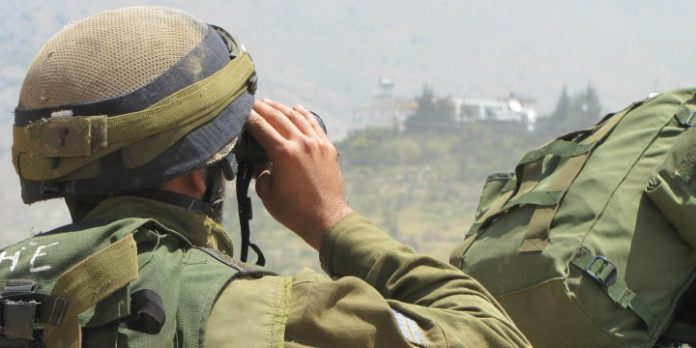
According to a report submitted on Tuesday by Israel’s Military Intelligence Directorate (Aman) outlining its security and defense projections for 2020, while the chances of a war being launched against Israel are low, there is a medium to high risk that events in Lebanon could devolve into war.
The 2020 assessment was updated following the U.S. airstrike in Iraq on Jan. 3 that killed Iranian Maj. Gen. Qassem Soleimani, commander of Iran’s elite Quds Force.
Aman views Soleimani’s elimination as a restraining factor, but one whose full ramifications have yet to be understood. The Israeli military believes that Soleimani’s successor, Maj. Gen. Esmail Ghaani, will find it very difficult to fill Soleimani’s shoes.
According to the assessment, Soleimani’s absence will have a direct effect on Israel. He was in charge of Hezbollah’s precision missile project as well as Iran’s plans to embed Shi’ite militias in Syria. Now Shi’ite states will have to make decisions about the future of those initiatives. The Israel Defense Forces (IDF) thinks that the militia project will proceed, while Hezbollah’s missile project could be shelved if Hezbollah leader Hassan Nasrallah concludes that it is more trouble than it is worth. According to Aman, Hezbollah currently has very limited precision missile capabilities, that are not yet operational.
The assessment also notes that Nasrallah is not seeking a war with Israel, but is willing to fight one to protect “the equation of deterrence.” Aman believes that “between-wars” military actions in Lebanon carry greater potential in the coming year to spark a larger-scale conflict than in the past. However, in light of Soleimani’s killing, it also believes Israel should step up its efforts against Iran’s attempts to entrench itself in Syria and elsewhere.
The assessment also touches on domestic matters in Lebanon and Iran, stating that both nations will likely remain bogged down in political and economic troubles this year.
U.S. sanctions on Iran have led to a significant drop in Iranian oil sales (from 2.8 million barrels per day two years ago to some 300,000 barrels in December 2019), dealing a serious blow to the Iranian economy, which is based mostly on oil revenues. As a result, Iran is blowing through its currency reserves and finding it difficult to offer its citizens hope. Nevertheless, the IDF sees the Iranian regime as “stable” and predicts that it will weather the current wave of popular protests.
However, Tehran will be forced to make some tough decisions in the coming year given the economic crisis and internal dissent, including whether and how to proceed with its nuclear program. While Iran has thrown off the limitations imposed by the 2015 nuclear deal, the IDF thinks Tehran is operating in a manner that will allow it to avoid going too far and keep some bargaining chips ahead of negotiations for a new agreement.
The IDF warned however that should Iran decide to move ahead with its nuclear program, it could enrich enough uranium to build a nuclear weapon by the end of the year, though it would need an additional year to achieve military nuclear capability. The assessment stressed that Israel is tracking Iran’s nuclear program to ensure Tehran is not working in any “secret channel” unknown to the West.
Closer to the border, the IDF believes that Syria will continue to present challenges, mostly in the Iranian context. Syrian President Bashar Assad is busy trying to complete his capture of the last two pockets of resistance to his regime, after which he will be busy trying to rebuild his country. The Syrian army has already begun a process of rebuilding that includes arms purchasing, and is renewing its work on chemical weapons, as well as biological weapons to a lesser extent.
Amid the backdrop of Syria’s desire for rehabilitation and Iran’s current domestic struggles, the IDF sees an opportunity for strategic change in Syria, even to the point of expelling the Shi’ite axis. This would require intervention and arrangements between the United States and Russia, which wants to deepen it foothold in the region.
Although Israeli officials aren’t noticing a change in the desire of the United States to reduce its Middle East presence, for the time being, at least, U.S. influence in the region is growing, primarily but not only due to the deterrence established by the killing of Soleimani. The Americans’ main challenge in the coming year according to the assessment will be in Iraq, where the fight over U.S. military presence will continue.
On the Palestinian front, Aman’s assessment points to stability in the Gaza Strip but the potential for destabilization in Judea and Samaria. The IDF believes that in the coming year Hamas will continue adhering to its understandings with Israel, with the aim of improving Gaza’s economic situation. With that, Hamas will not accept the conditioning of any further understandings on the release of Israeli prisoners and bodies of IDF soldiers it is holding, and also won’t agree to limit its efforts to arm itself.
With regard to Judea and Samaria, the IDF is again sounding an alarm over the possibility of Palestinian Authority succession battles should P.A. leader Mahmoud Abbas exit the picture, and also over the possibility of Hamas winning the planned general P.A. election. The terror threats from Judea and Samaria will not subside, and although they are expected to be smaller in scope, they are also predicted to be more professional and potent.
The Aman assessment also points to the growing challenges on the cyber and social media fronts, both in terms of Israel’s operations against its enemies and vice versa. In the coming year, the IDF intends to significantly increase its efforts in a variety of projects and subjects related to the field of information technology its use for intelligence gathering purposes.
This article first appeared in Israel Hayom.
(JNS)
{Matzav.com}











